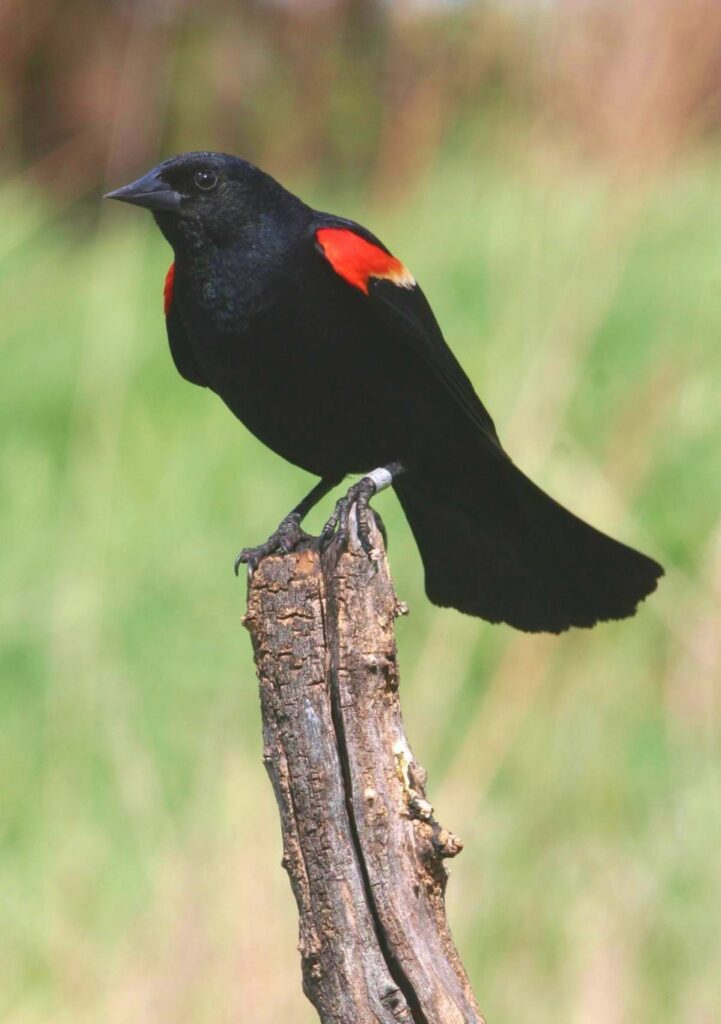Back Home by Chris Hardie
» Download this column as a Word document
» Download photos that accompany this story
» Chris Hardie’s headshot
The grass was heavy with dew and a foggy mist shrouded the creek bottoms as I arose early to begin the task of removing unused fence. I removed wire clips, rolled up barbed wire and pulled up the steel fence posts. My boots and pants were soon fully soaked.
As I worked my way through the dense marsh grasses the early-morning silence was interrupted by a harsh sound.
“Konk-la-ree”
“Konk-la-ree”
A male red-winged blackbird — actually several of them — did not like my presence and were quite vocal with their protests. Along with their screeches, they flew about my head, showing no fear of an unwanted creature in their territory.

Unmistakable with their red-orange shoulder patches trimmed in yellow, the males are easily identifiable. But the females are a nondescript brown and tan — perfectly suited for their role of building nests, laying eggs and rearing chicks. Their color is camouflage for protection against predators.
The noisy males arrive before the females to stake out their territory. And they fiercely defend it. A few years ago, the birds decided to build a nest in the middle of our raspberry patch and would dive-bomb any intruder. My wife, Sherry, took to arming herself with a tennis racquet. An uneasy truce was formed. No injuries were reported.
I discovered one of this past year’s nests in the grass. Females build the nest in just a few days with grass and mud. They usually lay three to four eggs, which are hatched in 11 to 12 days. The chicks go from blind and naked to leaving the nest two weeks after hatching. A female raises two or three clutches in a season, building a new nest each time.
There are an estimated 150 million of these birds in the United States. There’s a reason why there are so many; they are hell-bent on reproduction. Unlike the gentle mourning dove that mates for life, red-winged blackbirds are polygynous. They are nature’s swingers. Males defend as many as 15 females in their territory. But the females copulate with other males, resulting in clutches of mixed paternity. No blood tests are needed.
The birds are migratory and often fly in great numbers. A 2018 article in Madison Audubon quoted from the book “Wisconsin Birdlife” by Samuel D. Robbins, who recounted a recording from W.E. Snyder of Beaver Dam.
“On November 9, 1924, there occurred here, about 4 p.m., a flight of blackbirds, the like of which no local resident ever saw before. The procession, passing from due north to due south, was of such length that those in the lead as well as those in the rear, faded out into mere specks … the flight lasted for a full half-hour. The flight was at a great height, a solid column, unbroken by any bunched formation.”
Also among our avian farm friends are the ruby-throated hummingbirds, who have returned from their Mexican winter vacation. The males also are the first to return, staking out territory. We see plenty of the birds drinking nectar from blossoms; we also enjoy watching them at a feeding station on our porch.
A few years ago we had a delightful couple stay at our inn for a few days. They watched the hummingbirds with great joy and fascination. It was special to them, they said, because they had never seen a hummingbird before but said they were mentioned in the Quran.
“Do they not see the birds suspended in mid-air up in the sky? Nothing holds them there except Allah. There are certainly Signs in that for people who have belief.” – Surat an-Nahl, 79
The Bible doesn’t mention hummingbirds but they’re sometimes associated with the resurrection, sleeping still overnight like death before resuming boundless energy at dawn — messengers from heaven. Native Americans believe the birds are symbols of luck, devotion, permanence and the cycle of life.
The signs of spring are in full swing. Soon it will be summer.
The cycle of life turns.
Chris Hardie spent more than 30 years as a reporter, editor



